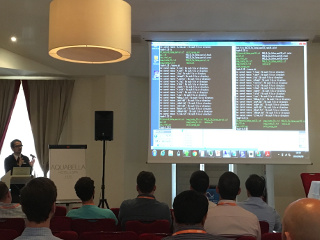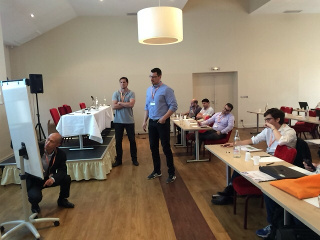Greeting
The JMAG Users Conference in Europe will be held this year in Aix-en-Provence, France as one of the programs in Powersys User Group 2016.
In addition to presenting the JMAG development roadmap, eight user presentations will also be given.
The presentations will address performing electromagnetic simulations on EV and PHEV alternators at their development site, as well as examples of using JMAG for multiphysics such as vibration, noise, and deformations.
At our workshops, discussions will be held on three topics: application, optimization & HPC, and material modeling, through demonstrations and introducing JMAG modeling technologies.
This is an excellent chance to gain insight on technical trends and application cases for electromagnetic field analysis. We hope to see you there.
Overview
| Host | POWERSYS |
|---|---|
| Dates | June 9th, 2016 08:15-17:15 June 10th, 2016 08:30-17:15 |
| Venue | Aquabella Hotel (Aix-en-Provence, France) 2 Rue des Etuves, 13100 Aix-en-Provence, France |
| URL |
We will hold a JMAG seminar focused on transformers at the Transformer Technology Symposium, an event to be hosted by ProSIM, a JMAG Group member based in India. We will introduce JMAG’s latest features through use cases to evaluate phenomena such as iron loss and stray loss in the core, and insulation durability.
Please come if you have an interest in transformer analyses.
Program
June 9th, 2016
| 08:15 – 09:00 | Welcome Coffee and Registration |
|---|---|
| 09:00 – 10:15 | Powersys Introduction : Strategic vision and discussion with partners |
| 10:15 – 10:45 | Coffee break |
| 10:45 – 12:00 |
Development planning of JMAG Takashi Yamada, Jsol Corporation JMAG is constantly being worked on to achieve highly accurate and high-speed simulation. JSOL would like to share our progress from the past year including parallel solvers to accelerate speed as well as GUI improvements aiming for increased productivity of analysis workflow. Analysis technologies we are currently focusing on and our plans for incorporation will also be covered in this presentation. Design exploration is an important topic this year. This presentation will discuss the present and future of JMAG. |
| 12:00 – 13:45 | Buffet lunch |
| 13:45 – 14:15 |
BLDC motor model using JMAG RT table for control development of an electromechanical actuator integrated in a sport vehicle suspension Isabel Ramirez Ruiz, Ferrari and co-autor : Prof. Federico Cheli, professor of the Mechanical Engineering department in the Politecnico di Milano. One of the main characteristic of a sport car is the drive pleasure at the limit of lateral and longitudinal adherence at the entrance and exit of the curve. To reach these targets an accurate studies of suspension kinematics and compliance together with the tire development has been made. A step further will be get with the integration of an intelligent active system into the vehicle suspension for a better control of the tire contact patch. The presented active system is an electromechanical actuator model part of the multibody model of the vehicle suspension. The actuator model is represented by the mechanical parts and electrical parts with a well detailed BLDC motor characteristics using the RT table from the JMAG FEM model. The virtual model will used for the BLDC motor control tune for a better achievement of the vehicle targets. |
| 14:15 – 14:45 |
Design and measurements of a prototype axial flux machine Marcel Lehr, Institut fur Elektrische Energiewandlung – TU Darmstadt. The results of the design, the construction and first measurements of an axial flux permanent magnet (AFPM) machine are summarized. The goal of this project was to build an axial flux machine with surface mounted magnets in the simplest possible way to use the machine as a demonstrator for small wheel hub drives with a reduced torque demand. Therefore the machine was designed as double-sided motor with internal stator and tooth-coil winding to enable a modular structure and two rotor discs. For the ease of a simple integration of the machine, the outer diameter was limited to a certain value. Therefore the design yield to a machine with 12 poles and 18 stator teeth (number of slots per pole and phase q = ½). 3D-electromagnetic and 3D-thermal studies with the finite-element-method (FEM) software JMAG were carried out. After the design of the active elements, the construction of the prototype was done. The machine was build up on a test bench and coupled with a load machine to compare the simulation results with the measurements. The measurements show that the electromagnetic properties (torque, efficiency) fit with the simulation results, but due to the open ventilation motor design the thermal behavior of the machine is better than assumed for the simulations. |
| 14:45 – 15:15 |
Electromagnetic and vibro-acoustic simulation of a claw-pole alternator: taking the stator manufacturing process into account Antoine Tan-Kim, Valeo Engine and Electrical Systems. This study shows the influence of the manufacturing process of a claw-pole alternator on its acoustic noise. First, the stator welds and the assembly of the stator in the brackets are linked to deformations of the inner diameter of the stator. Then, the influences of these deformations on the magnetic forces and the subsequent acoustic noise are investigated thanks to JMAG and LMS Virtual.Lab |
| 15:15 – 15:45 | Coffee break |
| 15:45 – 16:15 |
Comparison of Electromagnetic, thermal and electromagnetic excitation forces modeling with JMAG with experimental results Shinara Utegenova, Airbus Helicopters Nowadays, the electrical propulsion system enters intensely in the aerospace world. The machine technologies are compared in the context of their performances, dimensions and ability to satisfy the specific safety requirements. The aerospace applications require electrical machines with high power density and reduced size which lead to machine overheating because of high loss generation inside the machine and loss of performances. It is not a secret that design of an electrical machine is dependent on magnetic and electric loadings. High electromagnetic loadings cause the machine dimensions to increase, which is inadvisable in some applications. Reduced machine dimensions and high losses penalize the thermal behaviour of the machine. |
| 16:15 – 16:45 |
Using JMAG to simulate the performance and control of a brushless flux-switching motor James Nicholls, Technelec The single phase flux-switching motor is a cost-effective brushless machine that offers a compromise between the pulsed, electronically complex switched reluctance motor, and the smooth rotating field of the synchronous reluctance motor fed from a three phase inverter. |
| 16:45 – 17:15 |
Optimal Design of Electrical Rotating Machines using JMAG Aymen Ammar, Jeumont Electric JEUMONT Electric is a manufacturer of high power electrical rotating machines. In order to respond quickly to customers requirement JEUMONT Electric developed many tools based on analytical models. However, for specific requirements or to study local phenomena the use of Finite Elements Methods is unavoidable. In this presentation are presented some examples to show how JEUMONT Electric uses JMAG to optimally design high power electrical motors and generators. |
| 19:30 | Get together party in the “Grand théâtre de Provence” in Aix-en-Provence |
June 10th, 2016
| 8:30 – 9:00 | Welcome Coffee and Registration |
|---|---|
| 9:00 – 9:30 |
Design of a Claw-Pole Stator Exciter for a Synchronous Generator Alejandro Fernandez Sanchez, Moteurs Leroy Somer/GeePs. This presentation evaluates the use of an exciter with a claw-pole stator for a synchronous generator. Firstly, the transient 3D Finite Element Model made in JMAG is validated by experimental results. Then, based on the flux density distribution in the claw-pole stator, the structure is modified to improve performances. The influence on performances of some design parameters and the leakage flux is also discussed. |
| 9:30 – 10:00 |
Simulation of Pulse Magnetic Forming: Simulations and Experiments Dominique Deloison, Airbus Group High Speed forming processes provide advantages in terms of spring-back, formability and/or quality of the achieved components. The basic principle is as follows: a current is discharged within a coil, yielding to magnetic forces and a rapid acceleration of the part to form. The impact of the part on the tooling creates plasticity and leads to the final shape. |
| 10:00 – 10:30 |
Engineering optimization applied to the development of electro-mechanical systems Bertrand Monnier, Noesis Solutions Noesis Solutions develops a software platform that enables organizations to transform design exploration information into insight and insight into design decision. |
| 10:30 – 11:00 | Coffee break |
| 11:00 – 12:15 |
Workshop on the applications of JMAG (Seminar session) Powersys Team This session will be more dedicated to the application level. The new users of JMAG will be very welcome to this sessions. Some applications topics could be pre-selected, as for example:
Then, any topics coming for the attendees could also be treated. |
| 12:15 – 13:45 | Buffet lunch |
| 13:45 – 15:15 |
Workshop on the Optimization & HPC (demonstration session) Powersys Team This session will be mainly a demo session; user feedbacks and discussions will also be conducted. JMAG V15 has significantly improve the optimization tool and capabilities. JMAG is now able to do real multi-objective optimization and to output Pareto curves and correlation charts. This session will focus on:
|
| 15:15 – 15:45 | Coffee break |
| 15:45 – 17:15 |
Workshop on Material modelling (advanced session) Powersys Team This session will be an advanced session with a high scientific and technical level. In this session we will deal with loss calculation, full hysteresis modelling, material database from companies in EU:
User feedbacks will also be asked and discussions will be conducted base on this feedback in order to improve the JMAG tools. |
* Please note the conference details are subject to change due to unforeseen circumstances.
Visit the POWERSYS homepage for the latest information.
http://www.powersys-solutions.com/usergroup-2016/?page=agenda_jmag
Event Report
The JMAG Users Conference in Europe was jointly held with user conferences for EMTP (software for electrical power systems) and PSIM (circuit simulator) as one of the programs in Powersys User Group 2016.
Case study presentations were held in the mornings of the first and second days, and three workshops were held during the afternoon of the second day.
Valeo, who discussed the coupled magnetic field analysis and vibration/sound analysis of an alternator, and many other users such as Ferrari and Airbus presented invaluable user case studies. Even veteran users of JMAG found all of the cases useful.
Also in the workshops, we received many comments and questions regarding information provided by Powersys and JSOL. Multi-case and large-scale simualtions are steadily growing in popularity in Europe and, from the participants showing a keen interest with their questions, we noticed that this is in line with how JMAG is proceeding to develop these technologies.
Many users came to the conference with their challenges and by discussing them during the conference, they left with either answers to their problems or hints on how to solve them.
We felt that a great community was formed which allowed for all the JMAG users at the conference to heighten their skills in analysis.


Contact
POWERSYS
TEL: +33 (0)4 42 61 02 29
E-mail: marketing@powersys.fr


